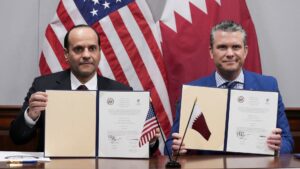As India steadily approaches the threshold of becoming a $5 trillion economy by 2026-27, interest in the MSME sector is soaring.
With over 51 million registered MSMEs, the sector face a credit gap of Rs. 20 trillion, in spite of them contributing more than 29% to the GDP.
In an exclusive interaction with ETBFSI, Scott Wang, Vice President, Asia Pacific, World Trade Centers Association (WTCA) and Dr. Vijay Kalantri, Chairman, MVIRDC World Trade Center, Mumbai shared their views on key issues around the future of MSMEs in India and how the sector can compete globally.
Q. How can India become a global hub for MSMEs?
Scott Wang:
With the favorable demographic structure, improving business environment and enhanced market accessibility, the pace of development is projected to sustain in the near future, which provides MSMEs great opportunities to thrive.
To make India a global hub for MSMEs, the public and private sectors in India need to work closely with each other to further improve infrastructure, streamline regulations, enrich financing sources and options, accelerate digitalization and innovations.
Dr. Vijay Kalantri:
India’s MSME sector needs world-class infrastructure such as roads, ports, logistics, uninterrupted power, market linkages, besides other facilities such as latest technologies, skilled labour to enhance their global competitiveness.
Access to collateral-free credit is a critical support that Indian MSMEs need to thrive in this highly dynamic global environment.
The government has increased the credit limit under the CGTMSE scheme for collateral-free loans from Rs 20 million to Rs 50 million last year.
We feel that the Rs 50 million cap is inadequate to meet the growing credit needs of MSMEs and hence the government should consider increasing this cap to Rs 100 million (USD 1.2 million).
MSMEs also face high cost of credit and hence the government and RBI should reduce cost of credit by cutting policy interest rates so that capital is available at a reasonable cost.
Q: Opportunities for MSMEs in the fintech ecosystem
Scott Wang:
Fintechs provide MSMEs with unprecedented level of access and convenience to financing options and mobile payment system which are critical for MSMEs to sustain growth and reduce costs.
It also makes it easier for MSMEs to access global market by digital payment, currency management and logistics system enabled by fintech-powered e-commerce platforms.
Dr. Vijay Kalantri:
Access to credit is a significant challenge that can be addressed by fintech technologies. MSME sector in India faces a credit gap of Rs 20 trillion which can be eased by fintech solutions.
India is among the leading nations when it comes to fintech, especially its digital payment systems. MSMEs can improve their business competitiveness by adopting innovative fintech solutions.
Fintech innovation is powered by frontier technologies such as Gen AI, blockchain, machine learning and Large Language Models. These digital technologies can help MSMEs overcome challenges and drive operational efficiency through access to a wide range of services.
Fintech solutions can bridge MSME credit gap and enhance the share of MSMEs in GDP and exports to 40% and 50% respectively.
Q. What needs to be done in terms of regulatory landscape for MSMEs in India?
Scott Wang:
Government can make compliance easier by simplifying regulations, streamlining process and enhancing accessibility. It can also take steps to provide MSMEs with better access to finance and credit. Labor laws can be more flexible so MSMEs can scale up and down based on the needs of market and growth
Dr. Vijay Kalantri:
Government may simplify procedures for starting business, registering property, resolving insolvency and enforcing contracts.
RBI may consider relaxing the regulation for classifying MSME loans as non-performing asset by extending the repayment period from 90 days to 180 days so that MSME borrowers who are facing genuine difficulties in repaying bank loans may get respite.
Q. Where do you see India’s MSME sector by 2030?
Scott Wang:
India will continue to lead the growth among major economies in the next decade, and have every reason to be optimistic about the prospect of MSME development.
Currently MSMEs contributes to 29% of national GDP and 50% of national exports in India. We are confident we’ll see MSME sector add more weights on both category in 2030.
Dr. Vijay Kalantri:
India’s aspiration to enhance the share of manufacturing in GDP to 25% from the current level of less than 17% opens huge opportunities for manufacturing MSMEs to grow.
India needs to upgrade its critical infrastructure such as power, road, ports, logistics and communication to reduce cost of doing business. Indian MSMEs suffer from huge logistics cost of 14-18% of GDP, compared to the global average of 8%.
Government may also come out with a concrete plan to revive sick MSME units whose businesses were affected by demonetization, pandemic and external economic shocks.










